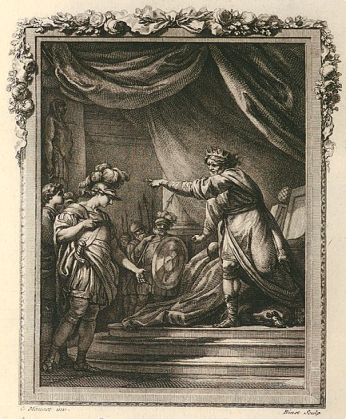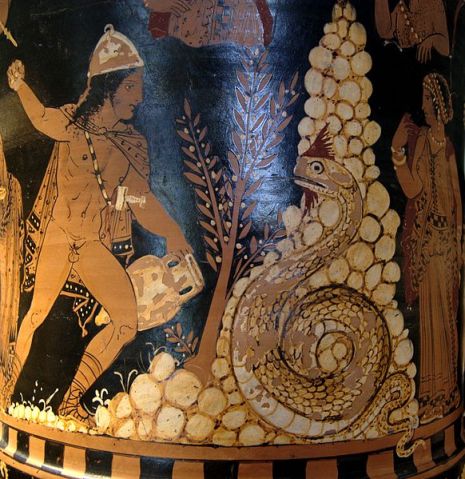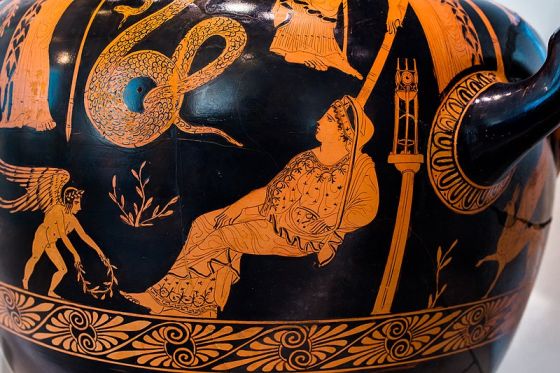Cadmus is a name that resonates deeply within the annals of Greek mythology. As the legendary founder of Thebes and the hero who introduced the Phoenician alphabet to the Greeks, his story is one of adventure, love, and transformation.
Cadmus Key Facts
| Parents | Agenor and Telephassa |
| Partners | Harmonia |
| Siblings | Europa, Cilix, Phoenix |
| Offspring | Agave, Ino, Autonoë, Semele, Polydorus |
| Other names | Kadmos |
| Roman name | Cadmus |
| Best Known Myth | Founding of Thebes and the Spartoi |
Name and Etymology
The name Cadmus is believed to have its roots in the Phoenician word “qadmūs”, which means “the east”. This etymology is fitting, considering Cadmus’s origins in the Phoenician city of Tyre and his journey westward to Greece. His Roman counterpart retains the same name, a testament to the hero’s widespread influence across cultures. Throughout various texts, Cadmus is also referred to by epithets and other names, such as Kadmos, emphasizing his Phoenician heritage.
Cadmus’ Family and Relationships

Born to King Agenor and Queen Telephassa of Tyre, Cadmus had a lineage that was nothing short of royal. His siblings included Cadmus’ sister Europa, who was abducted by Zeus in the form of a bull, leading to Cadmus’s quest to find her. This quest, though it did not reunite him with Europa, led him to many adventures and ultimately to the founding of Thebes.
Cadmus’s childhood was marked by the luxury and privilege of royalty, but it was his adulthood that truly defined him. His love story with Harmonia, the daughter of Ares and Aphrodite, is one of the most touching in Greek mythology. Their union was blessed with several children, including Agave and Semele, who would go on to have their own places in mythological tales.
Myths about Cadmus
The Quest for Europa
The tale of Cadmus begins with a heart-wrenching separation. His beloved sister, Europa, was not just any maiden; she caught the eye of the mighty Zeus. One fateful day, as Europa played by the seashore, Zeus, smitten by her beauty, transformed into a magnificent white bull and approached her. Drawn to the gentle nature of this creature, Europa climbed onto its back, only to be whisked away across the sea to Crete.
Distraught, Cadmus was tasked by his father, King Agenor, to find and bring back Europa. This mission was not just a quest of familial duty but also a journey filled with peril and divine interventions. Cadmus sought his sister far and wide, traveling through various lands, meeting different peoples, and facing numerous challenges. One of the most significant encounters was with the Oracle of Delphi, who, instead of guiding him to Europa, instructed Cadmus to follow a unique cow and establish a city where the cow would lay down. This prophecy led to the founding of Thebes, a city that would become central to many Greek myths.
The Spartoi and the Dragon

Upon reaching the destined location for Thebes, Cadmus and his companions were in dire need of fresh water. They soon discovered a sacred spring, but it was no ordinary one. Guarding this spring was a fearsome dragon, a creature of Ares, the god of war. The dragon was not just a guardian but a terror to those who dared approach the spring.
Realizing the necessity, Cadmus confronted the beast. The battle was fierce, with Cadmus employing all his skills and cunning. With divine favor and his determination, he managed to slay the dragon. But the story doesn’t end there. Athena, the goddess of wisdom, appeared to Cadmus and advised him to sow the dragon’s teeth into the earth. Heeding her advice, Cadmus was taken aback when, from the sown teeth, sprang forth fully armed warriors known as the Spartoi. These warriors, initially aggressive, turned on each other until only five remained. These five became the noble ancestors of Theban aristocracy, aiding Cadmus in establishing the city.
Marriage to Harmonia
After the tumultuous events at the spring, Cadmus found himself incurring the wrath of Ares for slaying his sacred dragon. To atone for his actions, Cadmus served Ares for eight long years. But every cloud has a silver lining. At the end of his servitude, a grand event awaited Cadmus. He was to marry Harmonia, the beautiful daughter of Ares and Aphrodite.
Their wedding was not just a union of two souls but a celebration that saw the attendance of numerous gods. Gifts were bestowed upon the couple, but one, in particular, stood out: a necklace given to Harmonia. This necklace, though exquisite, was cursed and would bring great tragedy to their descendants. Despite the looming shadow of the necklace, Cadmus and Harmonia’s love story remains a testament to the enduring power of love amidst trials and tribulations.
The Curse of the Necklace
The necklace, often described as golden and dazzlingly beautiful, was crafted by Hephaestus, the god of the forge. While its origins are shrouded in mystery, some say it was made by Hephaestus as a gift for Harmonia’s mother, Aphrodite, who later passed it on to her daughter. Others believe it was directly crafted for Harmonia as a wedding gift.
However, the necklace was cursed. It became a symbol of the tragic fate that would befall the lineage of Cadmus. Those who possessed or were associated with the necklace faced great misfortunes. Harmonia’s own children, including Semele and Agave, suffered tragic fates. Semele, while pregnant with Dionysus by Zeus, was tricked by Hera and consumed by flames, while Agave, under the spell of Dionysian madness, mistakenly killed her own son, Pentheus.
The necklace’s curse continued to plague the descendants of Cadmus for generations. It brought about madness, tragedies, and a series of unfortunate events to Thebes, the city Cadmus founded. The curse serves as a poignant reminder in Greek mythology about the transient nature of happiness and the lurking shadows of fate, even amidst moments of joy and celebration.
Depiction And Characteristics
Cadmus is often depicted as a determined and resilient hero. His journey from Phoenicia to Greece symbolizes his perseverance. In art, he’s frequently shown in the act of slaying the dragon or with the Spartoi. The dragon’s teeth, which he sowed into the ground, became a symbol of unexpected consequences and the idea that actions can lead to unforeseen outcomes.
His personality, as gleaned from myths, paints him as a dutiful brother, a brave warrior, and a wise king. The introduction of the Phoenician alphabet to the Greeks is also attributed to him, marking him as a figure of knowledge and culture.
Representations Of Cadmus In Art

The hero’s legendary feats have inspired countless artists over the millennia. Ancient Greek pottery often showcases Cadmus’s battle with the dragon, emphasizing his bravery and resourcefulness. In the Renaissance, his story saw a resurgence, with artists like Hendrick Goltzius depicting the moment Harmonia receives her cursed necklace.
Mentions in Ancient Texts
“Iliad” by Homer
Written around the 8th century BC, Homer’s epic poem “Iliad” recounts the events of the Trojan War. Within its verses, Cadmus is briefly mentioned as the founder of Thebes, a significant city in Greek myths that holds its place in the vast tapestry of stories that Homer weaves.
Quote:
“…in Thebes of the hundred gates, where the people owe their birth to Cadmus the Sown-men…”
“The Theogony” by Hesiod
Hesiod’s “The Theogony”, penned around 700 BC, offers an account of the origins and genealogies of the Greek gods. In this work, the lineage of Cadmus is explored in depth, connecting him to other notable figures in Greek mythology.
Quote:
“…And to Cadmus were born a daughter, Autonoë whom long-robed Aristaeus wed, and also Ino who was to taste the wrath of Hera…”
“Metamorphoses” by Ovid
Ovid’s narrative poem “Metamorphoses”, written in 8 AD, provides perhaps the most detailed account of Cadmus’s life. This work delves deep into various myths, vividly describing Cadmus’s journey, his battles, and his eventual transformation into a serpent alongside Harmonia.
Quote:
“…Cadmus, the guest of the strange land, followed the slow walk of the guiding cow, and chose that place for the walls of his city where she, wearied by the journey, sank down, and lowered her great side to the ground…”
Frequently Asked Questions
Cadmus is credited with founding the city of Thebes.
Following Athena’s advice, he sowed the dragon’s teeth, leading to the birth of the Spartoi warriors.
Europa, who was abducted by Zeus, prompting Cadmus’s quest.
They were transformed into serpents and sent to live in Elysium.
He’s believed to have introduced the Phoenician alphabet to the Greeks.
Their wedding was attended by many gods, showcasing its significance.
Featured Image Credit: Hendrik Goltzius, Public domain, via Wikimedia Commons
